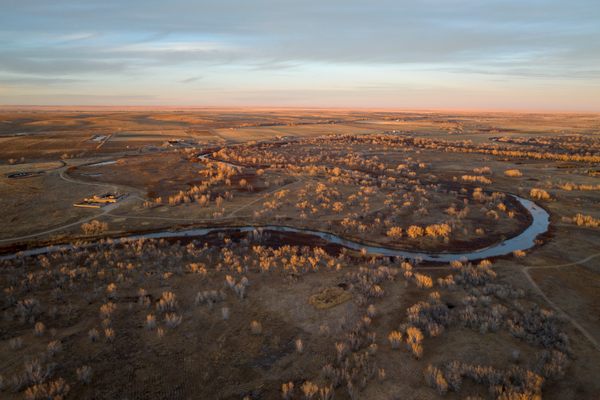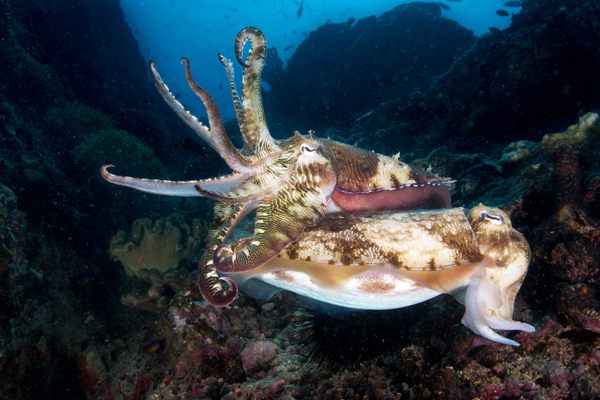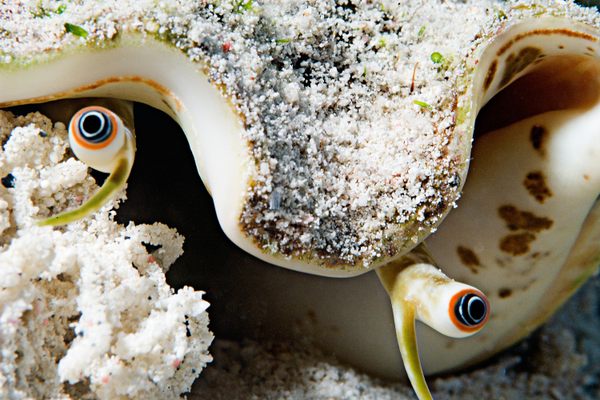Baby Sea Stars Are Voracious Predators That Might Just Save an Ecosystem
Along the Pacific Coast, fast and furious sunflower sea stars are vicious hunters as adults—and they’re even hungrier when young.
Along the northern Pacific coast, bright orange, blue, green, and pink sea stars hunt along the seafloor. The animals have as many as 24 arms and can get big, reaching the diameter of a bicycle tire, or about three feet across. Moving up to 200 feet an hour, these sea stars are fast—and furious. The sunflower sea star has a reputation as a vicious predator in its kelp forest ecosystem, swallowing prey—such as spiny sea urchin and hard-shelled mussels—whole.
While the adults may be impressive in size, new research shows that juveniles smaller than the eraser on a pencil may be the most voracious consumers. In a lab setting, they ate up to 10 times as much, proportionally, as adults. Being hungry isn’t uncommon for growing young, but in this case, it could have major implications for conservation.
That’s because sunflower sea stars are crucial predators for a healthy kelp forest ecosystem. While they’re not picky eaters, and will make a meal of anything from mussels to sea cucumbers, they primarily eat sea urchins, which helps keep the urchin population from exploding and overgrazing the kelp. The sea stars’ role in maintaining balance in their ecosystem is so important that scientists consider them a keystone species—remove the keystone, and the whole system can crumble. “It’s like a game of Jenga,” says biologist Jason Hodin at University of Washington’s Friday Harbor Laboratories. “You can remove a few pieces, but then you remove that one and everything sort of collapses.”

In 2013, the Jenga tower began to fall. A disease called Sea Star Wasting—which is still not well understood—struck on the West Coast. It reduced healthy sea stars to piles of rotten goo. “The sea stars essentially melt until there’s no tissue,” says senior aquarist Jennifer Burney at the Aquarium of the Pacific in California. “When you pick one up, it would be falling apart like a pile of wet tissue paper.”
Sunflower stars were hit the hardest, wiping out up to 90 percent of the population. Before, these voracious creatures covered a 2,000-mile-long range, from Alaska to Baja California. Now, sunflower stars have almost completely disappeared from California kelp forests, and the species overall is listed as critically endangered by the International Union for Conservation of Nature.
With the absence of the not-so-gentle giants, their sea urchin prey began to flourish, overgrazing the kelp forests many creatures rely on. “I think it’s difficult to overstate how shocking the kelp forest disappearance in California was during the last 10 years,” says Hodin. “That highlighted these generally understood connections between sea stars and urchins and kelp.”
In 2019, Hodin and his colleagues at Friday Harbor Laboratories, in the San Juan Islands, decided to take action. Through the support of The Nature Conservancy, they launched a breeding program focused on raising robust sea stars that would eventually be reintroduced to the dwindling kelp forests.

The problem was that no one had ever done that before, and not a lot was known about the life cycle of sea stars. No one was sure what juveniles ate, or how long raising them would take. During the project, Hodin and colleagues discovered that baby sea stars go from the size of a sand grain to that of a silver dollar in about a year, slowly adding arms as they continue to grow in their second year and beyond. We don’t even know how long they live, but given their massive manhole cover size, it’s likely a long time.
Through trial and error, and a lot of spawning, Friday Harbor Laboratories became the first to successfully breed the tricky species. The population begun with 30 wild-caught sunflower stars and is now “bursting at the seams,” says Hodin. Hundreds of stars now fill both the lab and several outdoor study tanks, as well as experimental cages out in the water. As word of the lab’s success spread, other aquarists across the country wanted to help. In August 2023, the Association of Zoos and Aquariums formed the Saving Animals From Extinction Sunflower Sea Star program, which has inspired groups across the country to successfully spawn their own sunflower sea stars, from California to Nebraska, and study how to protect the species.
While the goal of the work has always been to breed sea stars for release, Hodin says the proliferation of baby stars has also given him “the opportunity to do something that I’ve always wanted to do, which is trying to figure out what’s going on in the very, very early cryptic life stages of these stars.”

Inside the lab, Hodin points out rows of small plastic compartments—which are actually bead organizers—that he calls “mini condos.” Each one will hold a juvenile sunflower star the size of the period at the end of this sentence. Carefully, aided by a microscope, researchers use a pipette to transfer one tiny, five-armed sea star into its new home. Then they add an even smaller sea urchin larva.
At first, tiny sunflower stars will eat an urchin or two a day. About a month later—when they’ve already grown 10 times in size—they really get ravenous, says Hodin. At this point, feeding is more like the scene in Jurassic Park where they lower the cow into the raptor pen. While previous studies at the lab showed adult sea stars eat one adult urchin every other day or so—or at most two per day—the babies were seen eating an average of 10 urchins a day.
Right now, Hodin stresses he doesn’t want to jump to any conclusions—the team’s findings are awaiting peer review, and he plans to test his theory outside the lab. But he and his peers believe a fuller understanding of juvenile sea stars could influence the conservation strategy for the species—and for the entire kelp forest ecosystem. “These young life stages may actually be particularly key in understanding the ecology of kelp forests,” he says. “It’s not a huge logical leap to think that there might be some important ecological stories there that we’re not telling.”


































Follow us on Twitter to get the latest on the world's hidden wonders.
Like us on Facebook to get the latest on the world's hidden wonders.
Follow us on Twitter Like us on Facebook